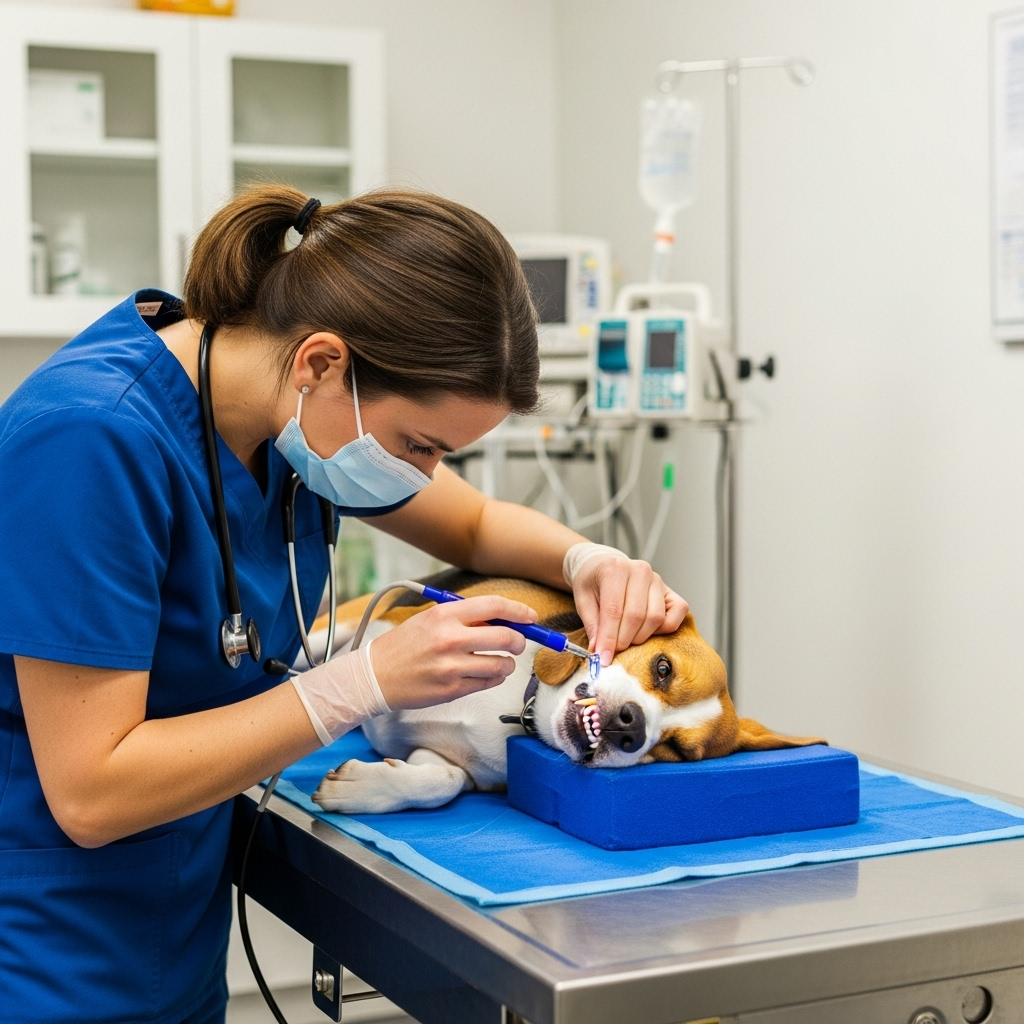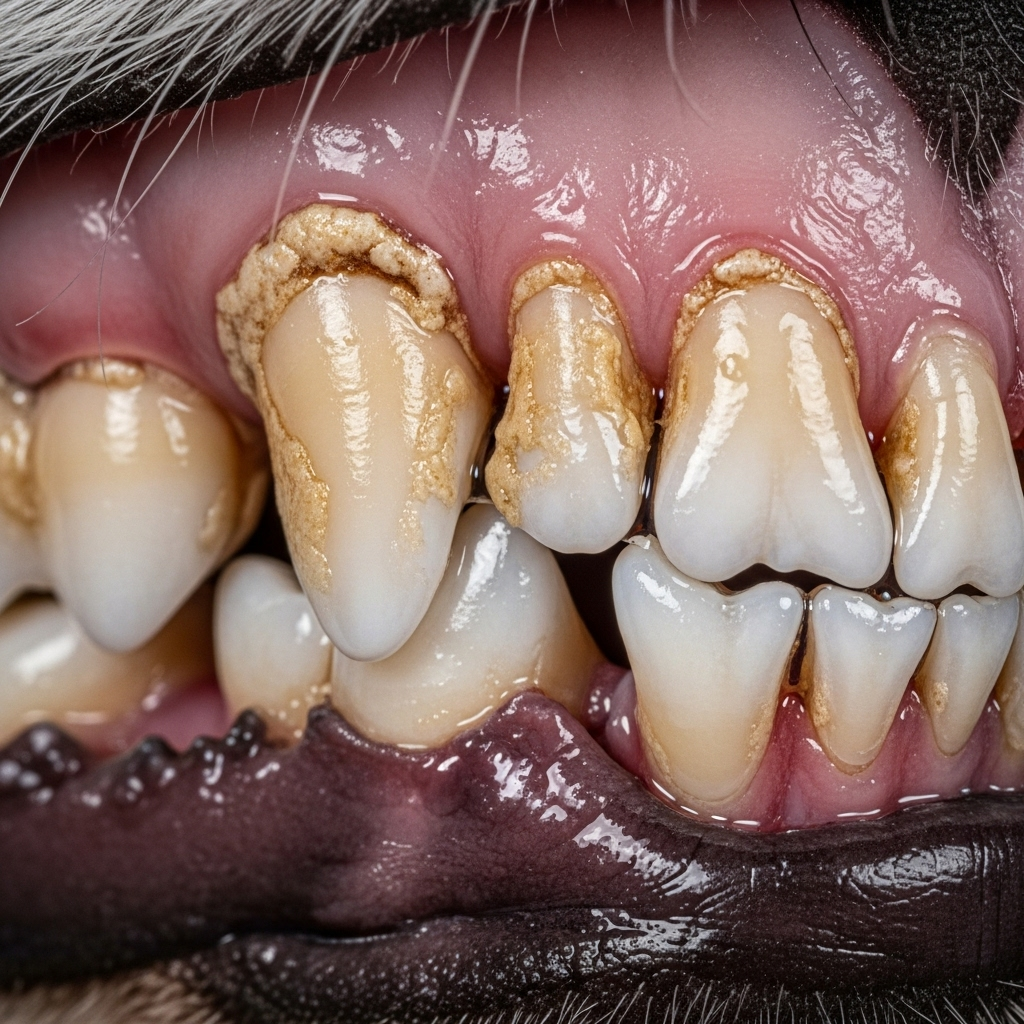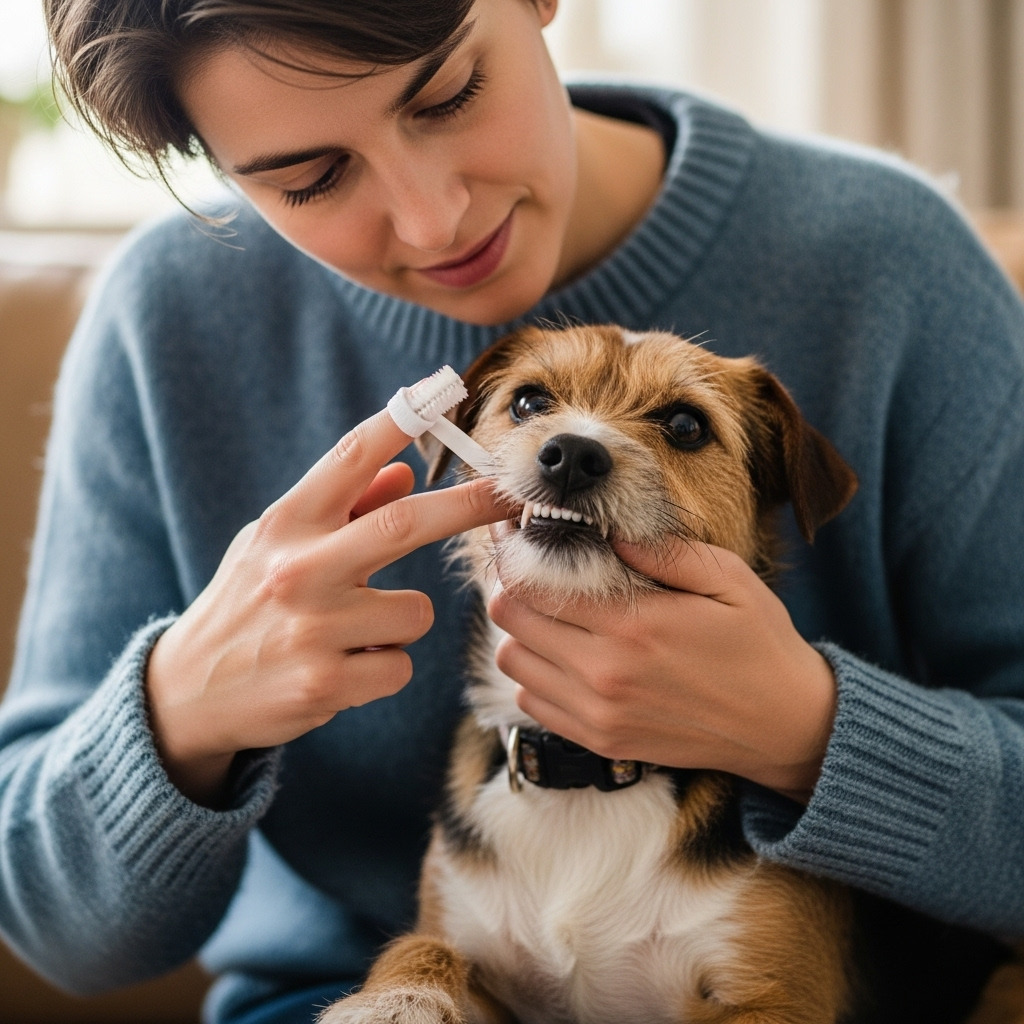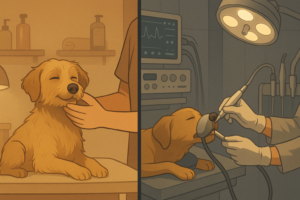Medical Disclaimer: This article is for informational purposes only and does not constitute medical advice. The content is not intended to be a substitute for professional veterinary advice, diagnosis, or treatment. Always seek the advice of your veterinarian with any questions you may have regarding your pet’s medical condition.
Table of Contents
That slightly “off” doggy breath you’ve been noticing might be more than just a quirky trait. As a vet here in Ottawa, I’ve seen countless owners dismiss it, but that odour is often the first warning sign of a silent disease that can have serious consequences for your dog’s entire body.
Key Takeaways
- What it is: Periodontal disease in dogs is a bacterial infection of the mouth that damages the gums, teeth, and jaw bone. It starts as invisible plaque and can progress rapidly.
- The Hidden Danger: Bacteria from the mouth can enter the bloodstream, traveling to and damaging vital organs. Recent research confirms a strong link between severe periodontal disease in dogs and problems with the heart, kidneys, and liver.
- The Gold Standard: The only way to properly diagnose and treat this condition is with a comprehensive anesthetic dental procedure at your vet clinic. This includes full-mouth X-rays to see the damage hidden below the gumline.
- Prevention is Key: Daily tooth brushing is the most effective way to prevent periodontal disease in dogs. Partnering with your vet for regular check-ups can stop the disease before it starts.
What Exactly Is Periodontal Disease in Dogs?
Think of your dog’s mouth as a bustling, microscopic city. When things are in balance, it’s a healthy environment. But when harmful bacteria start to take over, they build communities that lead to infection. This infection is the root cause of periodontal disease in dogs, and it’s incredibly common, affecting the majority of dogs over the age of three.
From Plaque to Problem: A Step-by-Step Breakdown
It all begins with plaque. Plaque is that soft, sticky, invisible film of bacteria that forms on teeth after every meal. If it isn’t brushed away, the minerals in your dog’s saliva cause it to harden into tartar (also called calculus) within just a few days.
This tartar is yellowish-brown, hard, and has a rough surface that is the perfect real estate for even more plaque to accumulate. According to the Merck Veterinary Manual, this buildup pushes under the gumline, causing inflammation (gingivitis) and creating pockets that harbour dangerous bacteria. This is the beginning of true periodontal disease in dogs.
The 4 Stages of Periodontal Disease
Also See: https://doglifeexpert.com/canine-obesity-devastating-risks-your-action/

Veterinarians grade the severity of the disease on a scale from 1 to 4.
- Stage 1 (Gingivitis): You’ll notice redness and swelling right where the gums meet the teeth. There might be some bad breath, but at this stage, there is no permanent damage. With a professional cleaning, Stage 1 is completely reversible.
- Stage 2 (Early Periodontitis): The infection has started to destroy the structures that attach the tooth to the jaw. Small pockets form under the gums, and X-rays will show less than 25% bone loss. The damage here is permanent, but we can stop it from getting worse.
- Stage 3 (Moderate Periodontitis): The bad breath is more noticeable now. The pockets are deeper, and the gums may be bleeding and receding. X-rays reveal significant bone loss up to 50%. The teeth may start to feel loose. This stage of periodontal disease in dogs is serious and painful.
- Stage 4 (Advanced Periodontitis): This is a state of severe infection. There is over 50% bone loss, the tooth roots may be exposed, and the teeth are often loose or falling out. There is a very high risk of bacteria spreading through the body, and the jaw itself can be at risk of fracturing.
The Hidden Danger: How Dental Health Affects Your Dog’s Whole Body
This is the part I need pet owners to understand: what happens in the mouth doesn’t stay in the mouth. The chronic infection and inflammation associated with periodontal disease in dogs can have devastating effects on their overall health.
The Heart Connection: A Pathway for Bacteria

Those red, bleeding, inflamed gums are a leaky barrier. They are full of tiny blood vessels that provide a direct highway for oral bacteria to enter your dog’s bloodstream. Once circulating, these bacteria can travel anywhere in the body.
One of their primary targets is the heart. The bacteria can attach to the heart valves, leading to a serious condition called endocarditis. This isn’t just a theoretical risk; a landmark 2019 study published in the Journal of Veterinary Internal Medicine confirmed a significant association between the severity of periodontal disease and the presence of acquired heart disease in dogs. I remember a case from early in my Ottawa practice, a sweet little Cavalier named “Pip” whose newly diagnosed heart murmur was directly linked by a specialist to his advanced dental disease. Treating his mouth helped manage his heart condition more effectively.
How the Kidneys and Liver Come Under Siege
Your dog’s kidneys and liver are the body’s master filtration systems. They work tirelessly to clear waste products and toxins from the blood. When a dog is living with advanced periodontal disease in dogs, there’s a constant shower of bacteria and inflammatory by-products circulating through their system.
As highlighted in comprehensive veterinary texts like the Saunders Manual of Small Animal Practice, this chronic inflammatory state forces these filtering organs to work overtime. Over months and years, this sustained assault can lead to microscopic damage, impairing their function and potentially contributing to the development of kidney or liver disease.
Could My Dog Be at Risk? Spotting the Subtle Signs
Dogs are masters at hiding pain, so they often won’t tell you their mouth hurts. It’s up to us to look for the clues. Ignoring the early signs of periodontal disease in dogs is what allows it to progress to the dangerous later stages.
Your 5-Minute At-Home Dental Health Checklist

Once a week, take a few minutes to check your dog’s mouth. Make it a positive experience with lots of praise.
- Sniff the Breath: Is there a new, foul, or “fishy” odour? Bad breath (halitosis) is the most common sign owners notice first.
- Lift the Lip: Gently lift their jowls on the side. Look at the big molars in the back first, as this is where tartar builds up the fastest. Do you see yellow or brown, hard material caked on the teeth?
- Check the Gums: Healthy gums are a uniform pink colour (unless they have natural pigmentation). Look for a bright red line where the gum meets the tooth. Are the gums swollen or puffy? Do they bleed easily if you touch them?
- Watch Them Eat: Are they suddenly chewing on one side of their mouth? Do they drop food, or seem hesitant to eat hard kibble or chews? Pain from periodontal disease in dogs can be subtle.
- Look for Other Changes: Have you noticed more drooling than usual? Or have they become head-shy, not wanting you to touch their face?
If you notice any of these signs, it’s time to book a check-up with your veterinarian.
Getting a Definitive Diagnosis: What Happens at the Vet Clinic
While your at-home check can raise a red flag, a definitive diagnosis of periodontal disease in dogs can only happen at the vet clinic. We can see the tartar and gingivitis on an awake exam, but the real damage is hidden from view.
The Anaesthetic Dental Procedure: Why It’s the Gold Standard
To truly assess and treat periodontal disease in dogs, we need to perform a Comprehensive Oral Health Assessment and Treatment, or COHAT. This has to be done under general anaesthesia, and here’s why:
- Safety and Comfort: It prevents pain and stress for your dog and allows the veterinary team to work safely.
- Full-Mouth X-rays: More than 60% of the tooth is below the gumline. Dental X-rays are the only way to see bone loss, root abscesses, and other problems hidden from sight.
- Subgingival Cleaning: The most harmful bacteria live in the pockets under the gums. We use specialised ultrasonic and hand scaling tools to clean these areas, which would be impossible on an awake animal.
- Probing: We use a tiny dental probe to measure the depth of the pockets around every tooth to determine the exact stage of the disease.
The American Veterinary Dental College (AVDC) is unequivocal on this point: anaesthesia-free dental procedures are purely cosmetic, provide no health benefit, and can give owners a false sense of security while the underlying periodontal disease in dogs gets worse.
Typical Costs for Canine Dental Care in Canada (Table)
Dental procedure costs can vary significantly based on your dog’s size, the severity of the disease, and your location in Canada. This table provides a general estimate.
| Service | Average Cost Range (CAD) | Notes |
| Pre-Anesthetic Bloodwork | $150 – $300 | Anaesthetic Dental Cleaning |
| Includes anaesthesia, monitoring, full-mouth X-rays, scaling, and polishing. Price varies with dog size. | $800 – $1,800 | Includes anesthesia, monitoring, full-mouth X-rays, scaling, and polishing. Price varies with dog size. |
| Tooth Extractions (per tooth) | $50 – $400+ | The cost depends on the size and location of the tooth and the difficulty of the extraction. |
| Total Estimated Cost | $1,000 – $3,000+ | This reflects a procedure that may or may not include extractions. Your vet will provide a detailed estimate. |
A Proactive Approach: Treating and Preventing Periodontal Disease in Dogs

The best treatment for periodontal disease in dogs is always prevention. Just like with our health, a little daily effort goes a long way.
4 Essential Steps for At-Home Prevention
Once your dog’s teeth have been professionally cleaned, your job is to keep them that way!
- Daily Tooth Brushing: This is the absolute gold standard. Core veterinary texts like Blackwell’s Five-Minute Veterinary Consult: Canine and Feline consistently emphasise daily brushing as the single most effective way to remove plaque before it turns into tartar. Use a dog-specific toothpaste (human toothpaste is toxic) and a soft-bristled brush.
- VOHC-Approved Dental Diets & Chews: Look for products with the Veterinary Oral Health Council (VOHC) seal. This means the product has been scientifically proven to reduce plaque or tartar.
- Water Additives & Dental Sprays: These can be a helpful addition to your routine, especially for dogs who won’t tolerate brushing. They help to reduce the bacterial load in the mouth.
- Regular Veterinary Check-ups: Your vet will check your dog’s mouth at every annual exam. This allows us to catch the early signs of periodontal disease in dogs and intervene before it becomes a major problem.
People Also Ask: Your Questions Answered
How much does treating periodontal disease in dogs cost in Canada?
The cost for a comprehensive dental cleaning and assessment for a dog in Canada can range from $800 to over $3,000. This price varies based on the dog’s size, the severity of the periodontal disease in dogs, whether extractions are needed, and your geographic location. The fee includes pre-anaesthetic bloodwork, general anaesthesia, monitoring, full-mouth dental X-rays, scaling, and polishing.
Can you reverse periodontal disease in dogs?
Stage 1 periodontal disease, which is just gingivitis, is completely reversible with a professional cleaning and consistent at-home care. However, once the disease progresses to stages 2, 3, or 4, the damage to the supporting structures of the teeth (bone and ligament loss) is irreversible. Treatment can halt the progression of the disease, but it cannot regrow lost bone.
Is my dog too old for a dental cleaning?
Age is not a disease. While the risks of anaesthesia increase with age, it is often safer to perform a necessary dental procedure on an older dog than to let them live with chronic pain and infection from advanced periodontal disease in dogs. Modern anaesthetic protocols and thorough pre-procedure screening are designed to make anaesthesia as safe as possible for seniors.
What can I use to prevent periodontal disease in my dog at home?
Daily tooth brushing with a vet-approved toothpaste is the gold standard for preventing periodontal disease in dogs. You can also use dental diets, water additives, and dental chews that have the Veterinary Oral Health Council (VOHC) seal of approval. These products have been proven to help reduce plaque and tartar buildup.
A Final Thought from Your Ottawa Vet
The link between a healthy mouth and a healthy body is just as strong for our dogs as it is for us. Overlooking the signs of periodontal disease in dogs means overlooking a source of chronic pain and an infection that can silently tax their most vital organs. But this isn’t a story meant to cause fear; it’s one of empowerment.
You have the power to change your dog’s health trajectory. It starts with a simple action: lifting their lip and taking a look. That one small gesture opens the door to a conversation with your veterinarian, a partnership dedicated to giving your best friend a longer, happier, and healthier life, free from the hidden dangers of dental disease. Don’t wait for the problem to become severe. Be proactive, be aware, and be the health advocate your dog deserves.




